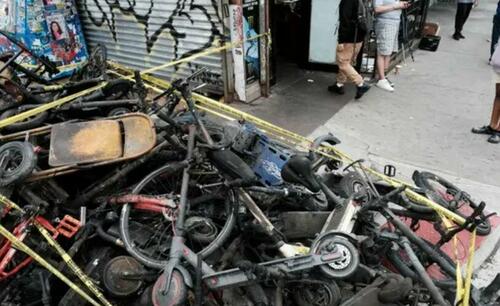Exploding E-Bikes: Lithium Battery Fires Spread In New York And California
BY TYLER DURDEN
FRIDAY, JUL 28, 2023 - 06:00 PM
Authored by Naveen Athrappully via The Epoch Times (emphasis ours),
Link:
https://www.zerohedge.com/technolog...battery-fires-spread-new-york-and-california/
 Lithium-ion batteries have sparked hundreds of fires across New York and San Francisco this year, injuring dozens and resulting in the death of a few individuals, triggering worries about ongoing public safety.
Lithium-ion batteries have sparked hundreds of fires across New York and San Francisco this year, injuring dozens and resulting in the death of a few individuals, triggering worries about ongoing public safety.
In New York, “fires caused by Lithium-ion batteries have grown exponentially every year since 2021,” Fire Commissioner Laura Kavanagh said on Friday during a
public safety briefing. “We are now, unfortunately, seeing more and more of these kinds of extremely fast-moving, very powerful fires with some regularity in the city.
As of this week, there have been 131 fires, 76 injuries, and 13 deaths caused by these Lithium-ion batteries.”
This is a significant jump from 2021 when there were 79 injuries and four deaths from such fires. In 2022, there were 142 injuries and six deaths. The 2023 death toll has already exceeded the past two years combined with roughly five months remaining in the year.
Multiple lithium-ion battery fires have made it to the headlines this year. On Jan. 20, a 63-year-old man was killed and 10 more injured after a fire from a charging e-bike spread through a home in Queens.
In April, a teenager and a 7-year-old child died in a home, also in Queens, due to a fire that erupted from an e-bike. And on May 7, four people died from a lithium battery fire that blazed through an apartment building in Upper Manhattan.
Lithium fires are also becoming a problem in San Francisco, California. On Monday, two people had to jump out of an apartment in the Tenderloin neighborhood due to a fire believed to have been triggered by an overheated e-scooter battery—with one of them taken to a hospital suffering from serious injuries.
In an interview with The New York Times, Capt. Jonathan Baxter, a spokesperson for the San Francisco Fire Department, said that it was the 24th fire in the city this year that was linked to rechargeable batteries.
Since 2017, San Francisco has seen 202 battery fires which injured eight people and killed one. Of these, 58 fires broke out in 2022, up from just 13 in 2017.
“We’re not seeing it to that same degree here in San Francisco,” Baxter said while referring to the surging lithium fire incidents in New York. “However, one fire is one too many.”
Lithium Fires in New York
Multiple reasons are cited for the surge in lithium fire incidents. Some point to
hazardous charging practices like the use of mismatched equipment to charge the devices and overcharging as a problem. Using damaged or refurbished batteries can also pose issues. Others blame a lack of proper safety testing and regulation.
Though lithium-ion batteries are also used in cellphones and computers, e-mobility devices pose a bigger threat as their lithium batteries tend to be larger and more susceptible to wear and tear.
Cheap e-bikes became popular in New York during the COVID-19 pandemic when public transit was affected and orders for food deliveries surged. People who buy e-bikes usually charge these vehicles inside apartments, posing a significant risk to the residents.
The situation has gotten so worse that some landlords in New York have banned e-bikes and other e-mobility devices.
In a March 20 press release, the City of New York admitted that “fires caused by batteries that power e-micromobility devices are a significant problem in New York City … These fires are particularly severe and difficult to extinguish, spreading quickly and producing noxious fumes.”
Even as NYC Mayor Eric Adams
promotes e-bikes as a “convenient transportation” option for New Yorkers, he admitted that faulty and illegal devices are making their way into homes and streets, triggering fires and “putting lives at risk.”
Lithium-ion batteries are also used in industrial settings. However, these setups are heavily regulated and subject to professional supervision. This is not the case with smaller lithium batteries used in e-bikes and other devices. Customers tend to usually not have much of an understanding of the fire risks posed by such batteries.
Dealing With Lithium Battery Fires
To deal with the problem of lithium battery fires, the Fire Department of the City of New York (FDNY) is recommending that citizens only buy lithium battery devices certified by a nationally recognized testing laboratory like Underwriters Laboratory (UL).
When using batteries, the manufacturer’s charging and storage instructions must be adhered to.
Batteries should be kept away from heat sources and anything flammable, and must be maintained at room temperature, it advises.
People should avoid using aftermarket or generic batteries. They should desist from overcharging and avoid leaving the batteries charging overnight. When charging, the battery should be away from a person’s bed, pillow, or couch. While charging e-bikes, FDNY advises people to never leave them unattended.
A bill
enacted in March seeks to prohibit the sale, lease, or rental of e-bikes and other such mobility devices as well as their storage batteries in New York which fail to meet certain safety standards. The ban will come into effect in September, making New York the first American city to do so.
The bill insists that e-mobility devices must be certified by an accredited testing laboratory for compliance with UL standards 2849, 2272, or similar safety standards set by the New York State Department of Motor Vehicles in consultation with the fire department.
“
The first violation of this law would be met with a warning, but subsequent violations would carry civil penalties of up to $1,000 per violating device,” states the bill summary.
63,883311
MORE TECHNOLOGY STORIES ON ZEROHEDGE

Watch: SpaceX Falcon Heavy Launches World's Largest Commercial Communications Satellite

WormGPT And FraudGPT Emerge As Scammers Weaponize AI Chatbots To Steal Data

NASA's Solid-State Battery Breakthrough Could Transform Air Travel






